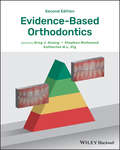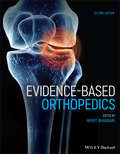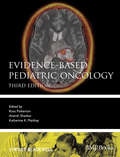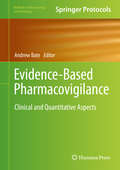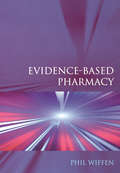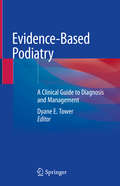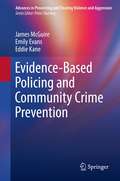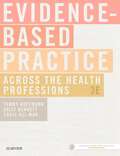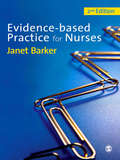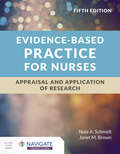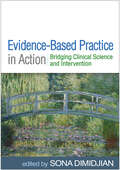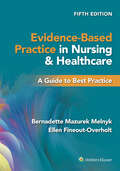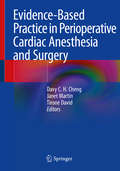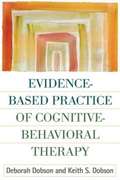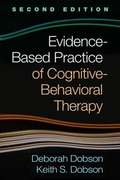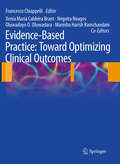- Table View
- List View
Evidence-Based Nursing: The Research-Practice Connection (Third Edition)
by Sarah Jo BrownEvidence-Based Nursing: The Research-Practice Connection, Third Edition introduces students to research methods and evidence-based practice (EBP). Written in an accessible style, the content moves readers through understanding how research is produced to appraisal at the critical thinking level. Timely information links evidence-based practice to recent work in the Safety and Quality programs that are underway in healthcare and nursing. Key Features:* Offers five common research designs, systematic reviews, and clinical practice guidelines by using a consistent, easy-to-read "Why-How-What" approach. * Exemplar research reports include "Profile and Commentary" that explain results of studies and help students better understand the methodological components of a study Accompanied by Instructor Resources:* Save time with a Test Bank and sample syllabus* Encourage critical thinking using additional learning activities, including discussion questions and small group assignments * Plan classroom lectures using PowerPoint Presentations created by the authorNavigate eFolio Now Available! Navigate eFolio: Evidence-Based Nursing , a fully supported and hosted online learning solution featuring an ebook and course management tools is also available for purchase. Navigate eFolio transforms how students learn and instructors teach by bringing together authoritative and interactive content aligned to course objectives, with student practice activities and assessments, an ebook, and reporting tools. For more information visit go. jblearning. com/nursingef
Evidence-Based Oral Surgery: A Clinical Guide For The General Dental Practitioner
by Elie M. Ferneini Michael T. GoupilThis book is designed to guide the dental practitioner in the medical and surgical management of the oral surgery patient. It provides dentists and dental professionals with up-to-date, evidence-based information on how to handle any oral surgical problem and how to work up a patient. The book is divided into five sections, the first two of which present overviews of general and basic perioperative topics and the principles of exodontia. Management of oral pathology is then discussed in detail, covering odontogenic infections, osteonecrosis, preprosthetic surgery, common oral pathology, biopsy techniques, and dentoalveolar trauma. The fourth section is devoted to topics in advanced oral surgery, such as disturbances of the temporomandibular joint apparatus, facial deformities, and dental implants. Finally, a series of illustrative case reports and unusual surgical cases is presented. The book is multi-institutional and multispecialty based. Both editors have extensive academic experience and have authored numerous scientific publications.
Evidence-Based Orthodontics
by Katherine W. Vig Greg J. Huang Stephen RichmondEvidence-Based Orthodontics, Second Edition retains important elements of the First Edition, with several new sections to improve its use as a quick and comprehensive reference. New updated edition of a landmark text that surveys the principles and practice of evidence-based orthodontics Offers practical strategies for professionals to incorporate EBO in their daily practices Presents brief summaries of the best evidence for a wide range of clinical topics Incorporates information from over 400 systematic reviews, listed by topic
Evidence-Based Orthopedics (Evidence-Based Medicine)
by Mohit BhandariEvidence-Based Orthopedics is an up-to-date review of the best evidence for the diagnosis, management, and treatment of orthopedic conditions. Covering orthopedic surgery as well as pre- and post-operative complications, this comprehensive guide provides recommendations for implementing evidence-based practice in the clinical setting. Chapters written by leading clinicians and researchers in the field are supported by tables of evidence that summarize systematic reviews and randomized controlled trials. In areas where evidence is insufficient to recommend a practice, summaries of the available research are provided to assist in decision-making. This fully revised new edition reflects the most recent evidence using the approved evidence-based medicine (EBM) guidelines and methodology. The text now places greater emphasis on GRADE—a transparent framework for developing and presenting summaries of evidence—to allow readers to easily evaluate the quality of evidence and the strength of recommendations. The second edition offers a streamlined presentation and an improved standardized format emphasizing how evidence in each chapter directly affects clinical decisions. Incorporating a vast amount of new evidence, Evidence-Based Orthopedics: Features thoroughly revised and updated content, including a new chapter on pediatric orthopedics and new X-ray images Provides the evidence base for orthopedic surgery as well as pediatric orthopedics and orthopedic conditions requiring medical treatment Covers the different methods for most orthopedic surgical procedures, such as hip replacements, arthroscopy, and knee replacements Helps surgeons and orthopedic specialists achieve a uniform optimum standard through a condition-based approach Aligns with internationally accepted guidelines and best health economic principles Evidence-Based Orthopedics is an invaluable resource for orthopedic specialists, surgeons, trauma surgeons, trainees, and medical students.
Evidence-Based Patient Handling: Techniques and Equipment
by Pat Alexander Sue Hignett Emma Crumpton Brian Fletcher Mike Fray Sue RuszalaProviding care and treatment for patients usually requires moving and handling activities associated with high rates of back injuries. The personal and financial cost of back pain and injuries to health staff means there is an urgent need to improve practice in this area. Over the past twenty years a number of guidelines have been published, however, these have been based on professional consensus rather than evidence. Evidence-Based Patient Handling tackles the challenge of producing an evidence base to support clinical practice and covers tasks, equipment and interventions. This book questions previously held opinions about moving and handling and provides the foundation for future practice.
Evidence-Based Pediatric Oncology
by Ross Pinkerton Katherine Matthay A. G. ShankarThis book is updated with evidence from the latest published reviews and is more clinically focused, with an emphasis on application of the trial findings. With increased coverage of trials in the area of supportive care for pediatric cancer patients, each chapter opens with a clinical question and concludes with a summary on the trial findings from an expert commentator.
Evidence-Based Periodontal and Peri-Implant Plastic Surgery
by Leandro ChambroneThis atlas, featuring numerous superb illustrations and vivid photographs, aims to create a bridge between research and practice in the field of periodontal plastic surgery and cosmetic dentistry with a view to enabling optimal decision making in daily practice. After an opening overview of evidence-based decision making and discussion of treatment planning, subsequent chapters address the surgical treatment of recession-type defects, use of soft tissue substitutes, aesthetic clinical crown lengthening and peri-implant plastic surgery. Illustrated case studies depict application of the described surgical procedures in daily practice and advice is provided on clinical indications and contraindications and basics of the surgical sequence. In addition, critical summaries of the results of systematic reviews are provided. Further chapters consider aspects of multidisciplinary decision-making and present decision trees for soft tissue augmentation procedures proposed by the American Academy of Periodontology. The atlas will be a valuable clinical guide for general dentists and specialists in periodontology/periodontics and implantology.
Evidence-Based Pharmacovigilance: Clinical and Quantitative Aspects (Methods in Pharmacology and Toxicology)
by Andrew BateThis book examines insights into the latest thinking and core concepts in areas of key methodological endeavor in Pharmacovigilance (PV), which strives to ever more effectively protect patients from harm caused by the medicines they need. Each book chapter tends to have a clear quantitative or clinical slant and an aim to provide an overview of methodological insights within a specific topic, while also providing a perspective on how the area is anticipated to develop in the future. Quantitative chapters focus more on statistical and epidemiological strategies and the thinking that underpins core developments in Pharmacovigilance, whereas clinical chapters focus on clinical methods for detecting hypotheses for and determining side effects of medicinal products as well as misdiagnosis pitfalls. Examples of areas of importance include signal detection, risk management, and risk benefit assessment.Vital and authoritative, Evidence-Based Pharmacovigilance: Clinical and Quantitative Aspects aims to provide readers with a sense of the advances that have occurred in pharmacovigilance methods and approaches, as well as inspiration and motivation to advance the field of pharmacovigilance with a strong sense that there is much more work to be done in ensuring the safe use of medications by patients.
Evidence-Based Pharmacy
by Phil WiffenThe effective delivery of primary care now requires a much higher calibre of staff than was previously considered acceptable. Selection, assessment and management are skills that need to be properly understood to ensure that the best possible service is being provided; and inappropriate actions can lead employers into a legal minefield with unwelcome consequences. This manual provides concise but comprehensive information on the situation as applied to general practice, illustrated by numerous case studies.
Evidence-Based Podiatry: A Clinical Guide to Diagnosis and Management
by Dyane E. TowerThis practical text reviews the most recent literature supporting clinical decisions regarding over a dozen common foot and ankle conditions, along with presentations of the techniques themselves, both surgical and non-surgical. The conditions are presented anatomically from forefoot to ankle, beginning with issues surrounding toenails, such as fungal infection and treatment of ingrown toenails, then proceeds to discuss the toes and toe joints, including hammertoe fixation, 2nd MPJ pathology, and Lapidus bunionectomy. Treatmentsfor arthritis of the midfoot and flatfoot follow, along with arthroscopy and arthroplasty of the ankle, surgical and non-surgical approaches for Achilles tendon ruptures, and treatments for Charcot neuroarthropathy, clubfoot and general considerations of wound care of the foot and ankle. Throughout, an emphasis is placed on the best available evidence for each treatment strategy.Evidence-Based Podiatry will be a valuable resource for podiatrists, orthopedic surgeons, and residents, fellows and trainees treating these common foot and ankle conditions.
Evidence-Based Policing and Community Crime Prevention (Advances in Preventing and Treating Violence and Aggression)
by Emily Evans James McGuire Eddie KaneThis book addresses and reviews progress in a major innovative development within police work known as evidence-based policing. It involves a significant extension and strengthening of links between research and practice and is directed to the task of increasing police effectiveness in the field of community crime prevention. This volume provides an international perspective that synthesizes recent research results from the United States and other countries – including systematic reviews of large bodies of evidence – to illuminate several of the most challenging issues currently confronting police departments. It examines recent advances in research-based models of policing and the expanding base in outcome evaluation.Key areas of coverage include:Managing the nighttime economy.Supervising sex offenders.Tackling domestic/intimate partner violence.Addressing school violence and the formation of gangs.Reducing victim and witness retraction and disengagement.Responding to mental disorders, safeguarding vulnerable adults, and providing victim support.Leveraging public awareness campaigns.In addition, each chapter presents an overview of key issues within a designated area, synthesizes existing reviews, and examines the most recent research. The book clearly and concisely presents major concepts, theories, and research findings, thereby providing both conceptual and analytic tools alongside an integrated presentation of principal findings and messages. The volume concludes with a discussion of current directions in research, key developments in policing strategies, and identification of effective operational structures for facilitating and sustaining research-practice links.Evidence-Based Policing and Community Crime Prevention is a must-have resource for researchers, clinicians and other professionals, and graduate students in forensic psychology, criminology and criminal justice, public health, developmental psychology, psychotherapy and counseling, psychiatry, social work, educational policy and politics, health psychology, nursing, and behavioral therapy/rehabilitation.
Evidence-Based Practice Across the Health Professions
by Sally Bennett Tammy Hoffmann Christopher Del MarEvidence-based Practice across the Health Professions is a contemporary guide to modern evidence-based practice. Fully revised and updated, it continues to keep the focus on the knowledge and skills that clinicians and students really need to make evidence-based informed decisions. It provides a foundation to help you to better ponder what clinical questions to ask, know ways to efficiently find research that answers those questions, know how to decide whether the results of research are believable, important and applicable and use good evidence with patients to provide healthcare as responsibly, effectively and collaboratively as possible.
Evidence-Based Practice for Nurses
by Janet Barker"Janet Barker understands the learning needs of her targeted readership. The text is a straight-forward yet comprehensive approach to evidence-based practice and it would be a valuable resource for students undertaking undergraduate nursing programmes. " - Dr. Jennifer Craig, University of York "A critically important text written with a clarity that communicates considerable knowledge, experience and enthusiasm. 'Evidence-based Practice for Nurses' is not only for students, practitioners and teachers but for every one of us committed to the development of nursing in the 21st century. " - Dr. Elizabeth Mason-Whitehead, University of Chester What is evidence-based nursing? How can I ensure my practice is based on the best evidence? Understanding what is evidence, how to appraise it and apply it to practice, are essential skills for all nurses. Taking a step-by-step approach, this practical book shows how to identify and evaluate the different types of evidence available and to critically appraise the studies that lie behind them. It also looks at the ways in which findings are integrated into practice, showing how research evidence can be applied to clinical-decision making and the delivery of patient care. Key features include: - reflective and problem-solving exercises - chapter summaries - further reading sections - self-test exercises and - glossary of key terms. Evidence-based Practice for Nurses is an engaging and easy to use book that will help the reader to enhance or change their professional practice. It has been designed to map onto the pre-registration curriculum and will be invaluable reading for all nursing students, as well as practitioners.
Evidence-Based Practice for Nurses: Appraisal and Application of Research
by Nola A. Schmidt Janet M. BrownEvidence-Based Practice for Nurses: Appraisal and Application of Research, Fifth Edition is an essential resource for teaching students how to translate research into practice.
Evidence-Based Practice for Nurses: Appraisal and Application of Research with Navigate Advantage Access
by Nola A. Schmidt Janet M. BrownEvidence-Based Practice for Nurses: Appraisal and Application of Research continues to be an essential resource for teaching students how to translate research into practice in an updated sixth edition. Built upon the foundation of the five step IDP process (knowledge, persuasion, decision, implementation, and confirmation), this comprehensive resource guides students through the hierarchy of evidence while interweaving concepts such as the evolution of nursing science, quality improvement projects and how they relate to evidence-based practice, as well as search strategies and how to choose a specific research design. Both students and instructors alike praise the organization and presentation of content from authors, Schmidt and Brown. They divided chapters into ‘bites', breaking down larger core concepts into smaller, easily digestible parts of the whole, ensuring nursing students grasp a key concept before progressing to the next.
Evidence-Based Practice in Action: Bridging Clinical Science and Intervention
by Sona DimidjianA growing number of empirically supported treatments are available to mental health practitioners, yet evidence-based practice requires knowledge and skills that are often overlooked in clinical training. This authoritative reference and text grounds the reader in the concepts, rationale, and methods of evidence-based practice. Clinicians and students are guided to consult and evaluate the research literature, use data to inform clinical decision making, consider the role of culture and context, craft sound case formulations, monitor progress and outcomes, and continuously develop their expertise. Of particular utility, the book includes rich, chapter-length case studies. Leading proponents of cognitive-behavioral therapy, dialectical behavior therapy, behavioral activation, and other approaches make explicit the ways they draw on evidence throughout the process of assessment and treatment.
Evidence-Based Practice in Complementary and Alternative Medicine: Perspectives, Protocols, Problems and Potential in Ayurveda
by Francesco Chiappelli Manisha Harish Ramchandani Sanjeev Rastogi Ram Harsh SinghThis book investigates the ways in which the evidence base is influencing complementary and alternative medicine in general and Ayurveda and allied health practices in particular. The latter have traditionally been prevalent in Asia and are now increasingly attracting interest worldwide. The book is divided into four sections, the first of which examines issues related to acquisition and evaluation of the evidence base. Evidence-based approaches to Ayurvedic diagnosis and therapy are then examined, with a special focus on management of cardiovascular and rheumatological diseases, dental care, and rejuvenating treatments. The final section explores further the challenges of applying evidence-based practice in contemporary and alternative medicine and Ayurveda with a focus upon the issues requiring urgent attention in ongoing decade. The same involves encompassing areas such as Ayurvedic pharmaceutics, practice, education and research within an evidence-based perspective.
Evidence-Based Practice in Nursing & Healthcare: A Guide to Best Practice
by Bernadette Mazurek Melnyk Ellen Fineout-OverholtEnhance your clinical decision-making capabilities and improve patient outcomes through evidence-based practice. <p><p> Develop the skills and knowledge you need to make evidence-based practice (EBP) an integral part of your clinical decision-making and everyday nursing practice with this proven, approachable text. Written in a straightforward, conversational style, Evidence-Based Practice in Nursing & Healthcare delivers real-world examples and meaningful strategies in every chapter to help you confidently meet today’s clinical challenges and ensure positive patient outcomes.
Evidence-Based Practice in Nursing & Healthcare: A Guide to Best Practice
by Bernadette Mazurek Melnyk Ellen Fineout-OverholtEnhance your clinical decision-making capabilities and improve patient outcomes through evidence-based practice. <p><p> Develop the skills and knowledge you need to make evidence-based practice (EBP) an integral part of your clinical decision-making and everyday nursing practice with this proven, approachable text. Written in a straightforward, conversational style, Evidence-Based Practice in Nursing & Healthcare delivers real-world examples and meaningful strategies in every chapter to help you confidently meet today’s clinical challenges and ensure positive patient outcomes.
Evidence-Based Practice in Nursing & Healthcare: A Guide to Best Practice
by Bernadette Mazurek Melnyk Ellen Fineout-OverholdEvidence-Based Practice in Nursing & Healthcare: A Guide to Best Practice, 5th Edition, is a bestselling, easy-to-use guide to translating research findings to nursing practice and applying practice data for superior clinical decision-making. Using conversational writing, inspiring quotes, and an enhanced, case-based approach, AJN award-winning authors Bernadette Melnyk and Ellen Fineout-Overholt demystify evidence-based practice to help students deliver optimal patient care and become better nurses.
Evidence-Based Practice in Perioperative Cardiac Anesthesia and Surgery
by Janet Martin Davy C. H. Cheng Tirone DavidThis comprehensive yet concise book addresses current best practice in the combined areas of cardiac surgery and anesthesia, interventional minimally invasive cardiac procedures, perioperative management and monitoring, and critical care recovery. This book not only provides the latest best practices in the perioperative management of cardiac surgical patients, but also it summarizes the current clinical guidelines and algorithms from leading cardiac programs and professional societies.Contemporary best practice approaches are written by experts from leading cardiac surgical centers. The preoperative, intraoperative and postoperative management and recovery of surgical patients, including medication, monitoring techniques, and innovative surgical procedures, are presented by experts in the field of cardiac anesthesia and surgery. Perioperative clinical care guidelines, postoperative recovery pathways and models of care are presented with supporting protocols.Evidence-Based Practice in Perioperative Cardiac Anesthesia and Surgery is aimed at all cardiac anesthesiology consultants, fellows, and trainees; all cardiac surgery consultants, fellows, and trainees; nurses in perioperative care and those involved in patient recovery management; cardiac program administrative professionals; and all critical care consultants and trainees looking after cardiovascular surgical patients in the modern era.
Evidence-Based Practice of Cognitive-Behavioral Therapy
by Keith Dobson Deborah DobsonFrom leading experts in the field a practicing clinical psychologist and a renowned psychotherapy researcher this book synthesizes the evidence base for cognitive-behavioral therapy (CBT) and translates it into practical clinical guidelines. The focus is how clinicians can use current research findings to provide the best care in real-world practice settings. Within a case formulation framework, core cognitive and behavioral theories and techniques are described and illustrated with vivid case examples. The authors also discuss managing everyday treatment challenges; separating CBT myths from facts; and how to develop a successful CBT practice and optimize the quality of services.
Evidence-Based Practice of Cognitive-Behavioral Therapy, Second Edition
by Deborah Dobson Keith S. DobsonSynthesizing the evidence base for cognitive-behavioral therapy (CBT) and translating it into practical clinical guidelines, this book has enhanced the knowledge and skills of thousands of therapists and students. The authors--an experienced clinician and a prominent psychotherapy researcher--discuss how to implement core CBT techniques, why and how they work, and what to do when faced with gaps in scientific knowledge. Vivid case examples illustrate what evidence-based strategies look like in action with real-world clients who may have multiple presenting problems. The authors also separate CBT myths from facts and discuss ways to manage common treatment challenges. New to This Edition *Revised throughout to incorporate the latest research, including key meta-analytic studies. *Chapters on clinical techniques have been restructured to be more concise and digestible. *New content on sleep difficulties, reducing avoidance, and motivational interviewing. *A new extended case example runs throughout the book.
Evidence-Based Practice: Toward Optimizing Clinical Outcomes
by Francesco Chiappelli Xenia Maria Caldeira Brant Manisha Harish Ramchandani Negoita Neagos Oluwadayo O. OluwadaraHealth care is witnessing an explosion of fundamental, clinical and translational research evidence. The emerging paradigm of evidence-based health care rests on the judicious integration of the patient needs/wants, the provider's expertise, and the best available research evidence in the treatment plan. The purpose of this book is to discuss the promise and the limitations of incorporating the best available evidence in clinical practice. It seeks to characterize and define how best available research evidence can be used in clinical practice and to what respect it applies to current public health issues.
Evidence-Based Practices and Treatments for Children with Autism
by Fred R. Volkmar Peter Doehring Domenic V. Cicchetti Brian ReichowAutism spectrum disorders (ASDs) have been increasingly diagnosed in recent years and carries with it far reaching social and financial implications. With this in mind, educators, physicians, and parents are searching for the best practices and most effective treatments. But because the symptoms of ASDs span multiple domains (e.g., communication and language, social, behavioral), successfully meeting the needs of a child with autism can be quite challenging. Evidence-Based Practices and Treatments for Children with Autism offers an insightful and balanced perspective on topics ranging from the historical underpinnings of autism treatment to the use of psychopharmacology and the implementation of evidence-based practices (EBPs). An evaluation methodology is also offered to reduce the risks and inconsistencies associated with the varying definitions of key autism terminology. This commitment to clearly addressing the complex issues associated with ASDs continues throughout the volume and provides opportunities for further research. Additional issues addressed include: Behavioral excesses and deficits treatmentCommunication treatmentSocial awareness and social skills treatmentDietary, complementary, and alternative treatmentsImplementation of EBPs in school settingsInterventions for sensory dysfunctionWith its holistic and accessible approach, Evidence-Based Practices and Treatments for Children with Autism is a vital resource for school psychologists and special education professionals as well as allied mental health professionals, including clinical child and developmental psychologists, psychiatrist, pediatricians, primary care and community providers.


